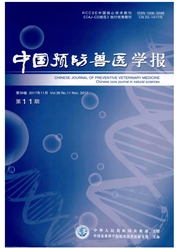

 中文摘要:
中文摘要:
本研究通过基因克隆技术以伪狂犬病病毒(PRV)弱毒疫苗株Bartha K61株的部分TK基因作为同源重组序列,以绿色荧光蛋白基因(EGFP)作为筛选标记,构建了带LoxP位点的pUCTKAB.EGFP质粒,将pBeloBACII线性化后插入到pUCTKAB—EGFP中构建了转移载体pUCTK-EGFP—BACII。将PRV基因组和转移载体共转染Vero细胞,利用同源重组在Bagha K61株的TK基因中插入了BAC质粒和绿色荧光蛋白筛选标记,经过11轮噬斑纯化和鉴定证实获得了带BAC质粒的重组伪狂犬病毒rv—PRVBAC。通过噬斑试验和一步生长曲线测定等方法对重组伪狂犬病毒rv—PRVBAC的生长特性进行研究,结果发现带有BAC质粒及筛选标记的重组病毒rv-PRVBAC在体外细胞培养中的增殖速度与亲本毒Bartha K61株相比没有明显差别,说明大的基因片段的插入没有影响重组病毒在体外的繁殖速度。重组病毒rv—PRVBAC在Vero细胞上盲传18代,其绿色荧光蛋白仍能够稳定表达,通过PCR鉴定可以检测到插入的外源片段和插入位点两侧的病毒基因序列,表明所获得的重组病毒rv.PRVBAC得到了稳定遗传。本研究成功获得了带BAC质粒的重组伪狂犬病毒rv-PRVBAC,为进一步开展PRV的细菌人工染色体的构建奠定了基础。
 英文摘要:
英文摘要:
In this study, a transfer vector pUCTK-EGFP-BACII was constructed by inserting the EGFP expression cassette and BAC plasmid pBeloBACII into two homologous sequences of TK gene of PRV Bartha K61 strain. The recombinant virus (rv- PRVBAC) was obtained by co-transfecting the transfer vector and PRV genome into Vero cell, followed by 11 passages of plaque purification based on EGFP expression. The rv-PRVBAC was shown to contain BAC plasmid and had similar growth profile in vitro as its parental virus Bartha K61, indicating the large fragment of BAC plasmid insertion in the TK gene didn't influence the replication of rv-PRVBAC in cell culture. The virus remained stable after 18 passages on Vero cell. The recombinant virus rv-PRVBAC reported here could serve as foundation for further study on bacterial artificial chromosome of PRV.
 同期刊论文项目
同期刊论文项目
 同项目期刊论文
同项目期刊论文
 期刊信息
期刊信息
